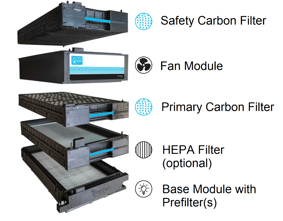.jpg?width=1640&height=924&name=Ductless%20Fume%20Hoods%20Cover%20(4).jpg)
How much do you really understand ductless fume hoods? Are you picturing a small, portable, single-wall ductless enclosure? Or are you envisioning periodic manual sampling of the exhaust air and frequent filter changes to ensure there is no chemical breakthrough of the carbon filters? If so, don’t worry, these are common misconceptions based on older technology and designs. Read on to learn more about the important differences between full-featured ductless fume hoods (aka “filtered fume hoods”) and the basic ductless enclosures you remember.
Ductless fume hoods are standard chemical fume hood super superstructures with smoothly operating sash systems, lighting, electrical outlets, and plumbing fixtures, that have been equipped with filtration technology. A safely designed airflow structure using filtration technology that includes redundant safety filters and chemical breakthrough sensors provides the safest, highest-capacity ductless fume hood available. Don’t confuse ductless fume hoods with the small, acrylic single-wall ductless enclosures of old that lack the fire resistance, physical strength, and agency approvals (UL, CSA, etc.) that fume hoods must possess.
The 2024 edition of NFPA 45, Standard on Fire Protection for Laboratories Using Chemicals, contains three new sections with over twenty subsections and extensive Annex material dedicated to ductless fume hoods. These new sections cover product requirements, proper selection/application, safety training, testing, and maintenance. For those who are familiar with the standard’s previous editions, you know that progressing from an old Annex statement “…only applicable for use with nuisance vapors and dusts…” to today’s edition “Ductless fume hoods meeting the requirements of Sections 7.8 and 7.15 shall be permitted to discharge to the laboratory work area or laboratory unit.” is a major leap forward. I encourage you to purchase the 2024 edition of NFPA 45 and see the changes firsthand.
There is now near harmonization across North America’s lab standards for ductless fume hood requirements. ANSI/ASSE Z9.5-2022, Laboratory Ventilation and CSA Z316.5-2020, Fume Hoods and Associated Exhaust Systems standards each contain equipment, performance, testing, and selection requirements very similar to NFPA 45-2024. If you are considering ductless fume hoods for your next project, please make sure to work with reputable manufacturers, and their representatives, whose equipment fully complies with these latest edition standards.
Ductless fume hoods are excellent additions to existing labs. For example, if a researcher, chemist or teacher needs to add one more fume hood to a lab that is already running above 100% HVAC capacity, it will be prohibitively expensive and disruptive to upgrade the HVAC system’s capacity. Provided that the chemicals being used are acceptable and approved for the filtration system, adding a ductless fume hood will be much easier, faster and less costly. Similarly, when designing a new lab like undergraduate chemistry teaching that is “hood exhaust driven” (meaning the lab is over-ventilated due to the total hood exhaust airflow), a combination of ducted and ductless fume hoods can help reduce air change rates to the required levels, minimize the new HVAC equipment’s size and maximize flexibility.
In summary, ductless fume hoods are standard, code compliant fume hood structures with filters on top. Anything less is a ductless enclosure (as defined by NFPA 45-2024). Each new application of a ductless fume hood must be thoroughly reviewed and approved before applying it. Going ductless on some of your hoods can deliver numerous benefits including lower capital expenses, lower operating expenses, less HVAC equipment to maintain, and fewer pollutants in our environment. A true win-win-win!
References:
ANSI/ASSP Z9.5-2022, Laboratory Ventilation
CSA Z316.5-2020, Fume Hoods and Associated Exhaust Systems
NFPA 45-2024, Standard for Fire Protection for Laboratories Using Chemicals
Author:
Ken Crooks, Business Development A/E
New England Lab, www.newenglandlab.com
O: 781-932-9980 x8808

 copyright 2014, new england laboratory casework co., inc
copyright 2014, new england laboratory casework co., inc 

